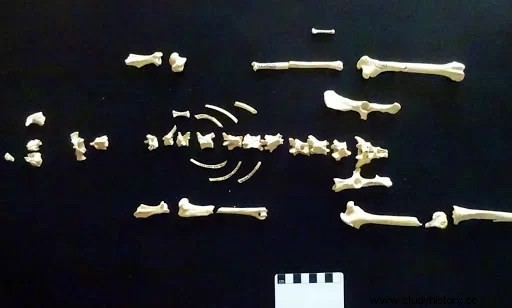A recent study suggests that brown hares and chickens were first treated as gods, not food, when they arrived in Britain during the Iron Age.
Archaeological evidence shows that the first brown hares and chickens to reach Britain were carefully buried and intact. There are no signs of butchery on the bones examined, and investigations suggest that both animals were not imported for people to eat.
The work of experts from the Universities of Exeter, Leicester and Oxford is revealing when brown hares, rabbits and chickens were introduced to Britain, and how they became incorporated into modern Easter traditions.
The team previously analyzed the earliest rabbit bone found in the country, dating to the 1st/2nd century AD. New radiocarbon dates from bones found at sites in Hampshire (Houghton Down, Weston Down, Winnal Down and Winklebury Camp) and Hertfordshire (Blackhorse Road) suggest that brown hares and chickens were introduced to Britain even earlier, arriving simultaneously. during the Iron Age, between the 5th and 3rd centuries BC

The discovery of buried remains dovetails with historical evidence that neither animal was used for food until the Roman period, which began hundreds of years later.
Julius Caesar says in his Comments on the Gallic Wars that the British consider it contrary to divine law to eat hares, chickens and geese. However, they breed them for their own amusement and pleasure . The 3rd century AD author Cassius Dio wrote that Queen Boudica released a live hare to divine the outcome of her battle with the Romans, thus invoking the goddess Andraste to ensure her victory.
During the Roman period, both species were bred and used for food, and rabbits were also introduced. But in 410 AD the Roman Empire withdrew from Great Britain causing an economic collapse. Rabbits became locally extinct, while populations of chickens and brown hares collapsed. Due to their scarcity at this time, chickens and hares regained their special status.
Professor Naomi Sykes, from the University of Exeter, who led the research, said:Easter is a major British festival, but none of its iconic elements are native to Britain. The idea that chickens and hares initially had religious associations is not surprising, as cross-cultural studies have shown that exotic things and animals are often given supernatural status.
Historical accounts have suggested that chickens and hares were too special to be eaten and instead were associated with deities – chickens with an Iron Age god similar to Roman Mercury, and hares with a hare goddess unknown female. The religious association of hares and chickens lasted throughout the Roman period.
However, archaeological evidence shows that as their populations increased, they were increasingly consumed, and even hares were raised as cattle. Instead of being buried as individuals, the remains of hares and chickens were disposed of as food waste.
After the Romans left Britain, people stopped hunting hares and this may explain why archaeologists have found few remains of the animal until the medieval period. In contrast, chicken populations increased. This is likely because in the 6th century Saint Benedict forbade the consumption of meat from four-legged animals during fasting periods such as Lent. The rules of it were widely adopted in the 10th and 11th centuries, increasing the popularity of chickens and eggs as fast-day foods.
Historical and archaeological evidence shows that rabbits were reintroduced to Britain as food for the elite during the 13th century AD. Rabbits were increasingly common in the 19th-century landscape, which likely contributed to the hare's replacement as the Easter bunny when festival traditions were revitalized during the Victorian period.
